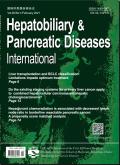Safety and effectiveness of balloon catheter-assisted ultrasound-guided percutaneous microwave ablation in difficult-site liver cancer
IF 4.4
3区 医学
Q2 GASTROENTEROLOGY & HEPATOLOGY
Hepatobiliary & Pancreatic Diseases International
Pub Date : 2025-02-01
DOI:10.1016/j.hbpd.2024.09.012
引用次数: 0
Abstract
Background
Balloon catheter isolation is a promising auxiliary method for thermal ablation treatment of liver cancer. We aimed to explore the safety and effectiveness of balloon catheter isolation-assisted ultrasound-guided percutaneous microwave ablation (MWA) in treating liver cancer in difficult anatomical locations.
Methods
Data of 132 patients with 145 difficult-site liver cancer treated with ultrasound-guided percutaneous MWA were retrospectively analyzed. Participants were classified into the isolation (n = 40) and non-isolation (n = 92) groups based on whether the patients were treated using a balloon catheter prior to ablation. The major complication rates, local tumor residuals (LTR), and tumor follow-up for local tumor progression (LTP) at 6 and 12 months post-ablation were compared between the two groups.
Results
The rates of major postoperative complications did not significantly differ between the isolation and non-isolation groups (2.5% vs. 4.3%, P = 0.609). The postoperative LTR rates were significantly different between the isolation and non-isolation groups (4.8% vs. 17.5%, P = 0.032). Balloon catheter isolation [odds ratio (OR) = 0.225, 95% confidence interval (CI): 0.085–0.595, P = 0.009] and tumor diameter (OR = 2.808, 95% CI: 1.186–6.647, P = 0.019) were identified as independent factors influencing LTR rate. The cumulative LTP rates at 6 and 12 months after ablation showed no significant differences between the isolation and non-isolation groups (2.6% vs. 7.9%, P = 0.661; 4.9% vs. 9.8%, P = 0.676, respectively). Cox proportional hazards regression analysis showed that tumor diameter was an independent risk factor for cumulative LTP rate (OR = 3.445, 95% CI: 1.406–8.437, P = 0.017).
Conclusions
Balloon catheter isolation-assisted MWA was safe and effective in the treatment of difficult-site liver cancer. Additionally, tumor diameter significantly influenced LTR and LTP rates after ablation.
球囊导管辅助超声引导经皮微波消融术治疗疑难部位肝癌的安全性和有效性。
背景:球囊导管隔离是一种很有前景的肝癌热消融治疗辅助方法。我们旨在探讨球囊导管隔离辅助超声引导下经皮微波消融术(MWA)治疗疑难解剖部位肝癌的安全性和有效性:回顾性分析了132例145个疑难部位肝癌患者在超声引导下经皮微波消融术治疗的数据。根据患者在消融前是否使用球囊导管进行治疗,将参与者分为隔离组(n = 40)和非隔离组(n = 92)。两组患者的主要并发症发生率、局部肿瘤残留(LTR)以及消融术后6个月和12个月的局部肿瘤进展(LTP)随访情况进行了比较:隔离组和非隔离组的术后主要并发症发生率无明显差异(2.5% vs. 4.3%,P = 0.609)。隔离组和非隔离组的术后 LTR 发生率有显著差异(4.8% 对 17.5%,P = 0.032)。球囊导管隔离[几率比(OR)= 0.225,95% 置信区间(CI):0.085-0.595,P = 0.009]和肿瘤直径(OR = 2.808,95% CI:1.186-6.647,P = 0.019)被认为是影响 LTR 率的独立因素。消融术后6个月和12个月的累积LTP率在隔离组和非隔离组之间无显著差异(分别为2.6% vs. 7.9%,P = 0.661;4.9% vs. 9.8%,P = 0.676)。Cox比例危险回归分析显示,肿瘤直径是累积LTP率的独立危险因素(OR = 3.445,95% CI:1.406-8.437,P = 0.017):结论:球囊导管隔离辅助MWA治疗疑难部位肝癌安全有效。结论:球囊导管隔离辅助 MWA 对难治性肝癌的治疗安全有效,此外,肿瘤直径对消融后的 LTR 和 LTP 率有明显影响。
本文章由计算机程序翻译,如有差异,请以英文原文为准。
求助全文
约1分钟内获得全文
求助全文
来源期刊
CiteScore
5.40
自引率
6.10%
发文量
152
审稿时长
3.0 months
期刊介绍:
Hepatobiliary & Pancreatic Diseases International (HBPD INT) (ISSN 1499-3872 / CN 33-1391/R) a bimonthly journal published by First Affiliated Hospital, Zhejiang University School of Medicine, China. It publishes peer-reviewed original papers, reviews and editorials concerned with clinical practice and research in the fields of hepatobiliary and pancreatic diseases. Papers cover the medical, surgical, radiological, pathological, biochemical, physiological and historical aspects of the subject areas under the headings Liver, Biliary, Pancreas, Transplantation, Research, Special Reports, Editorials, Review Articles, Brief Communications, Clinical Summary, Clinical Images and Case Reports. It also deals with the basic sciences and experimental work. The journal is abstracted and indexed in SCI-E, IM/MEDLINE, EMBASE/EM, CA, Scopus, ScienceDirect, etc.

 求助内容:
求助内容: 应助结果提醒方式:
应助结果提醒方式:


